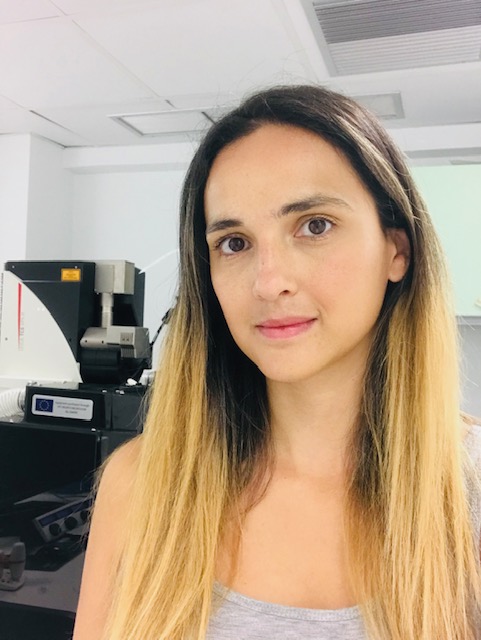
Our research group belongs to the Laboratory of Molecular Genetics and became independent since March 2023.
Our main scientific research focuses on the study of the functions of the CNS in normal and pathological conditions, mainly in the context of neuroimmunology and neurological diseases. Using experimental models, transgenic animals, confocal and two-photon microscopy, molecular and immunological techniques, bioinformatics and behavioral animal models, we study cell-specific functions of the CNS to identify molecular mechanisms and specialized molecular targets with clinical relevance and/or therapeutic potential against neurodegenerative and other neurological disorders. We specialize in the study of microglia, the resident immune cells of the brain parenchyma, in health and disease.
1. Microglia-driven pathology and altered brain surveillance in demyelination
Microglia are the brain parenchyma-resident macrophages with various functions in health and disease. They are highly motile cells that constantly extend and retract their processes to perform brain surveillance, an homeostatic function by which they scan the tissue for possible infections, tissue damage and other pathological insults to resolve them. In pathology, they change their morphology and functions and they may have both beneficial and detrimental roles, depending on the disease context. We wish to understand how brain microglia respond to demyelinating insults and how their behavior changes in recovery. To do so we developed a novel histopathological analysis approach in 3D and a cell-based analysis tool (https://github.com/VKyrargyri/MicroApp) that when applied in the cuprizone model revealed region- and disease- dependent changes in microglial dynamics in the brain grey matter during demyelination and remyelination (Roufagalas et al., 2021).
2. Imaging microglial dynamics in neuroinflammation
In this project we aim to monitor microglial dynamics and their interactions with other glial cells and neurons during disease progression, using the well-established Experimental Autoimmune Encephalomyelitis (EAE) in mice, which models autoimmune components of chronic relapse-remitting MS. We have developed the chronic in vivo two photon imaging of microglia in the brain of mice with EAE and perform the analysis of their morphology and motility longitudinally during disease progression using bioinformatic approaches in 3D.
3. Brain resident microglia versus other tissue macrophages in MS models
The brain resident macrophages, which are the parenchymal microglia, the perivascular, meningeal and choroid plexus macrophages, have common cell origin with macrophages in the peripheral tissues. As a result, they share common molecular signatures making it challenging to differentiate their functions in neuroinflammatory diseases in which peripheral macrophages invade into the CNS. To deal with this, we employ constitutive knockout and tamoxifen-inducible gene-targeting approaches, immunological techniques, genetics and bioinformatics and currently seek to clarify the specific role of the brain resident microglial NF-κB molecular pathway versus other tissue macrophages in EAE.
4. Microglial dynamics in perinatal infection-mediated neurodevelopmental disorders
Maternal immune activation (MIA) caused by viral infection during pregnancy has been linked to an increased risk of neurodevelopmental diseases (NDDs), like schizophrenia and autism, later in life. This link may be bridged by defective microglial functions in the offspring. Changes in microglia phenotype towards inflammatory states as well as excessive synaptic pruning by dysregulated phagocytosis are some of the proposed mechanisms by which microglia may drive pathophysiology in NDDs. We aim to discover novel microglia-driven mechanisms that may contribute to perinatal infection-induced NDDs, with particular interest in the role of the human virus SARS-CoV-2.
- Hellenic Pasteur Institute (2024-2027): Scholarship for PhD studies to Gerasimos Nakas.
- Hellenic Pasteur Institute (2022-2023): Fellowship and research fund for postdoctoral research to Vasiliki Kyrargyri. A project entitled ‘protective roles of microglia and their dynamics in neuroinflammation’.
- Hellenic Foundation for Research & Innovation (H.F.R.I.) (2018-2021): research fund (180.000 euro) to Vasiliki Kyrargyri to run a postdoctoral research project, entitled ‘microglia-driven pathology and altered surveillance in demyelination’, as independent principal investigator.
2024
IKKβ deletion from CNS macrophages increases neuronal excitability and accelerates the onset of EAE, while from peripheral macrophages reduces disease severity, Avloniti M., Evangelidou M., Gomini M., Loupis T., Emmanouil M., Mitropoulou A., Tselios T., Lassmann H., Gruart A., Delgado JM., Probert L. & Kyrargyri V. Journal of Neuroinflammation, accepted on January (2024). DOI: 10.1186/s12974-024-03023-9
2021
Roufagalas, I., Avloniti, M., Fortosi, A., Xingi, E., Thomaidou, D., Probert, L., & Kyrargyri, V. (2021). Novel cell-based analysis reveals region-dependent changes in microglial dynamics in grey matter in a cuprizone model of demyelination. Neurobiology of Disease, 157, 105449. DOI: 10.1016/j.nbd.2021.105449
2020
Kyrargyri, V., Madry, C., Rifat, A., Arancibia-Carcamo, I. L., Jones, S. P., Chan, V. T. T., Xu, Y., Robaye, B., & Attwell, D. (2020). P2Y(13) receptors regulate microglial morphology, surveillance, and resting levels of interleukin 1β release. Glia, 68(2), 328–344. DOI: 10.1002/glia.23719
2019
Nortley, R., Korte, N., Izquierdo, P., Hirunpattarasilp, C., Mishra, A., Jaunmuktane, Z., Kyrargyri, V., Pfeiffer, T., Khennouf, L., Madry, C., Gong, H., Richard-Loendt, A., Huang, W., Saito, T., Saido, T. C., Brandner, S., Sethi, H., & Attwell, D. (2019). Amyloid b oligomers constrict human capillaries in Alzheimer’s disease via signaling to pericytes. Science, 365(6450). DOI: 10.1126/science.aav9518
Kyrargyri, V., Attwell, D., Jolivet, R. B., & Madry, C. (2019). Analysis of Signaling Mechanisms Regulating Microglial Process Movement. In Methods in Molecular Biology (Vol. 2034). DOI: 10.1007/978-1-4939-9658-2_14
2018
Papazian, I., Kyrargyri, V., Evangelidou, M., Voulgari-Kokota, A., & Probert, L. (2018). Mesenchymal stem cell protection of neurons against glutamate excitotoxicity involves reduction of NMDA-triggered calcium responses and surface GluR1, and is partly mediated by TNF. International Journal of Molecular Sciences, 19(3). DOI: 10.3390/ijms19030651
Madry, C., Arancibia-Cárcamo, I. L., Kyrargyri, V., Chan, V. T. T., Hamilton, N. B., & Attwell, D. (2018). Effects of the ecto-ATPase apyrase on microglial ramification and surveillance reflect cell depolarization, not ATP depletion. Proceedings of the National Academy of Sciences of the United States of America, 115(7). DOI: 10.1016/j.neuron.2017.12.002. *Equal 2nd author.
Madry, C.*, Kyrargyri, V.*, Arancibia-Cárcamo, I. L.*, Jolivet, R.*, Kohsaka, S., Bryan, R. M., & Attwell, D. (2018). Microglial Ramification, Surveillance, and Interleukin-1β Release Are Regulated by the Two-Pore Domain K+ Channel THIK-1. Neuron, 97(2). DOI: 10.1016/j.neuron.2017.12.002. *Equal 1st author.
